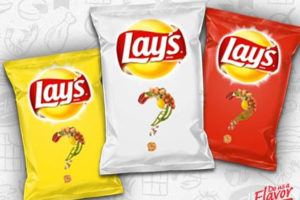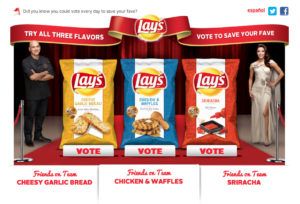Crowdsourcing Your Next Chip Flavor: Lay’s “Do Us A Flavor” Campaign

A blog post on the positive and negative aspects of Pepsi’s Do Us A Flavor Campaign. Do the results of crowdsourcing campaigns signal long-term consumer interests or are they just short-term fads?
PepsiCo’s “Do Us A Flavor” Crowdsourcing Campaign:
PepsiCo, an American multinational food, snack and beverage company, has done a great job of using external crowdsourcing to spark product innovation and renew consumer enthusiasm for its iconic Lay’s potato chip brand. Pepsico first launched the “Do Us A Flavor” campaign in the United States in July 2012 with a pop-up store in Times Square showcasing its current 22 Lay’s flavors. The Company then created a Facebook page that offered participants the ability to easily submit proposals for new potato chip flavors. Once submitted, users received a generated image of a Lay’s bag customized to reflect their submitted flavor. Participants could then share their Lay’s image on their social media platforms.  PepsiCo also partnered with Facebook to turn the usual “Like” button on the platform to an “I’d Eat That” button. The cover photo on the Facebook page was used as a rotating billboard with the top submissions shown. After the submission deadline, a panel of judges including celebrity chef Michael Symon and actress Eva Longoria, helped narrow the submissions down to the top 3. The three flavors were then supplied in stores for customers to buy and sample. PepsiCo then opened the final decision up for public vote. The creator of the winning chip flavor would win $1 million or 1% of the 2013 net sales of the winning flavor, whichever is greatest.
PepsiCo also partnered with Facebook to turn the usual “Like” button on the platform to an “I’d Eat That” button. The cover photo on the Facebook page was used as a rotating billboard with the top submissions shown. After the submission deadline, a panel of judges including celebrity chef Michael Symon and actress Eva Longoria, helped narrow the submissions down to the top 3. The three flavors were then supplied in stores for customers to buy and sample. PepsiCo then opened the final decision up for public vote. The creator of the winning chip flavor would win $1 million or 1% of the 2013 net sales of the winning flavor, whichever is greatest.
PepsiCo’s first US crowdsourcing campaign was a huge success and created value for both the Company itself and its consumers! Three flavors were selected as the finalist flavors: Cheesy Garlic Bread, Chicken & Waffles, and Sriracha. 
The Company’s goal was to generate social media buzz among its millennial customers within the 18-34 age demographic and receive about 1.2 million flavor submissions. Their hope was that this would subsequently result in a +3% uplift in sales. During the Company’s ten-month campaign, it received 3.8 million submissions, achieved over 22.5 million Facebook page visits and ultimately experienced a sales uplift of +12% year over year. The campaign was such a success that PepsiCo chose to launch the campaign globally.
Positive Aspects of PepsiCo’s Crowdsourcing Efforts:
The primary benefit of PepsiCo’s crowdsourcing campaign is that the Company was able to gain insights into consumer preference and behaviors at a low cost. The Company also generated positive brand awareness – specifically with the millennial population that it was originally struggling to attract. Furthermore, the Company was able to substantially shorten the product development life cycle by instead launching a product in 10 months versus the usual 15-20 month time frame. There are also cost benefits related to a reduced need for a large Research & Development team due to product development being outsourced to the public.
Negative Aspects of PepsiCo’s Crowdsourcing Efforts:
While the Company experienced a short-term uplift in sales due to the campaign, there are some inherent risks in using crowdsourcing for product development purposes. Many of the winning chip flavors in various countries have since been discontinued due to weak or inconsistent sales. This may suggest that the flavors that win are more of a novelty and do not specifically align with long-term consumer interests. Furthermore, this could actually result in significant losses for the Company related to unsold inventory. If PepsiCo continues to use this campaign as a means of product innovation, then it may need to consider whether the winning flavors are in fact a way of driving long-term brand loyalty or just a novelty that will shortly wear off. What flavor is next? 
Sources:
http://www.chiefmarketer.com/pro-awards-winners/best-idea-or-concept-gold
http://kwhs.wharton.upenn.edu/2015/05/lays-lesson-in-brand-awareness/
http://www.pepsico.com/live/content/topic/Do-Us-A-Flavor
http://gaia.adage.com/images/bin/pdf/DUAF_GlobalFlavors_FastFacts_FINAL.pdf





Thanks Brittany! Interesting that Pepsi is facing issues with the long-term success of winning flavors. To your point, maybe these new flavors don’t solve the same job that the original Lays chips solve, and the customer job for a more unique flavor is fleeting in nature (i.e., “I just want to try something new for a few times then move on”). If this is the case, I wonder if this product development engine could serve a marketing purpose. I’m thinking of fast food franchises that often promote special, expiring deals or new products to drive more customer traffic. Maybe in the future, limited release flavors serve as a way for us to reengage with the brand, and Pepsi offers us some sort of incentive to stick with the brand (e.g., coupons for original Lays when we buy chicken and waffle Lays). Any examples of this that you’ve seen?
Great post! I can’t believe that the campaign delivered 12% year over year sales growth – that is remarkable! Your points regarding the negative aspects of the campaign are very interesting. I wrote about Lego and they take an opposite approach to this same situation and face challenges of their own. Instead of the Lay’s approach in which the winning flavor is guaranteed to be sold in stores, Lego only promises that ideas which receive a certain level of support will go through an official review process with the “Lego Review Board” which will determine whether the project will ultimately be produced. By going this route, Lego can avoid many of the negative results that you mentioned for Lay’s (because they won’t have to produce ideas that they don’t think will attract lasting demand). However, they risk alienating their community in instances like the one depicted in the link below in which none of the highly supported ideas are chosen for production. I guess there’s not one correct way to manage this issue, each brand must judge for itself whether there is greater risk in feeling forced to move forward with a questionable crowdsourced idea or risk disempowering the community by layering their own judgement on top of the crowdsourced results.
https://www.youtube.com/watch?v=oOZPnLjakOQ